

 |
 |
|||||||||
 |
|
Memories of the 39th CIESM Congress (Venice, 10-14 May 2010) |
|
CIESM, with precious logistic assistance from ISMAR - CNR, did conclude its 39th International Congress in Venice Lido on 14 May 2010, after five days of intensive work attended by some 1,000 scientists. A record number of communications (over 900), covering marine disciplines from marine geophysics to microbiology, were presented in 50 distinct sessions. In addition morning Panels, each concluded by a general debate with the pluri-disciplinary audience, did attract a lot of interest, together with sessions reviewing the progress of CIESM initiatives on alien species, multibeam seabed mapping, Hydrochanges, Tropical Signals, Mussel Watch and Jelly Watch. |
|
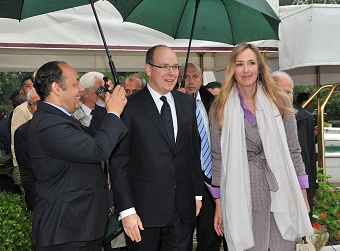
|
On Monday 10 May the President of CIESM, H.S.H. Prince Albert II of Monaco, and the Italian Minister of the Environment, H.E. Ms Stefania Prestigiacomo, officially opened the 39th International CIESM Congress at the Palazzo del Cinema.
After warm words of welcome from the Mayor of Venice, the Italian Minister expressed her sense of pride in welcoming in her country, for the first time since 1992, the largest and most representative marine research forum in the Mediterranean Basin. The inaugural address of Prince Albert highlighted the diversity and the dynamism of the Mediterranean Commission. In his words, the many 'scientists from 40 countries assembled here were giving sense to the concept that CIESM was a unique, powerful Alliance of researchers without border'. He emphasized the essential role of CIESM in bridging the many shores of the Mediterranean Sea, in proposing innovative solutions based on its diversity of cultures, and in monitoring fast changes at work in this enclosed sea – a true barometer of the Global ocean. |
arriving at the Palazzo del Cinema for the inauguration. |
|
In his inaugural report, the Director General of the Commission, Dr Frederic Briand, captured the spirit of the place – host of the mythical Mostra di Venezia – by illustrating CIESM development, from its conception in 1910 to its current acomplishments, with multiple cinematographic references largely borrowed from Italian filmography. His presentation struck the minds by mixing images from over 30 celebrated movies with key issues that would be developed during the Congress week, such as marine geohazards, jellyfish blooms, ocean acidification, overfishing, deep sea warming, blue biotechnologies, tropical species invasion, etc. You may see film of inaugural presentations at Frederic Briand announced the decision of the CIESM Board, taken one day before, to unite in protecting the economic interests of Mediterranean against the risk of massive exploitation of their marine genetic resources by foreign companies. He concluded by drawing attention to the opening by CIESM of bridges between academic research and other actors of maritime economy, which would be illustrated by various panels all through the week. |
|
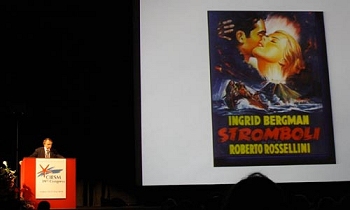
|
|
by CIESM Director General. |
|
| |
|
| The scientific sessions were very well attended, from Monday till Friday evening, covering a great diversity of topics that ranged from paleoceanography, microbiological techniques, shoreline evolution, large scale variability, modeling and forecasting, catastrophic events, alien species, tsunamis alerts, fish physiology, satellite data, global warming, economic impacts, mapping of top marine predators to coastal restoration. |
|
The quality, dynamism and large number of scientists from the Maghreb and from Turkey did attract particular attention, drawing a recurring remark : "the CIESM Congress is the reflection of the best that Mediterranean marine research has to offer". Morning Panels offered a glance at the new interactions opened by CIESM to closely link marine researchers and civil society, in domains as diverse as the fishery industry, biotechnological business and marine transport. |
|
All communications, plus a synthesis of the Panels, will be soon published in the 39th Congress Volume that will be made available to the Marine Institutes of CIESM Member States. Podcasts of the panels have been graciously provided by CNR, Direzione Centrale Supporto alla Programmazione e alle Infrastrutture - Rep. Servizi Multimediali e Documentali (Rome, Italy). |
|
|
|
A large number of posters – 425 – were presented at the Congress. On Wednesday afternoon their authors delivered in each committee room a 2 min oral presentation of their main findings. For many young scientists, who chose this mode of communication, this was their first opportunity to present their work in front of an international audience. By all accounts this short, highly focused mode of expression was considered highly effective. This success brought the Board to conclude that this experience should not only be reconducted but extended to a majority of communications at the next Congress. |
|
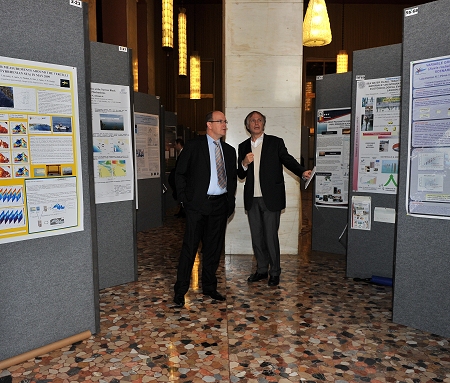 |
|
Following this successful experiment, the Congress participants were invited to taste a large selection of the best Veneto wines presented in style by the Federation of Italian Sommeliers (FISAR). Unsurprisingly this wine (and cheese) tasting turned out to be one of the best attended features of the day. |
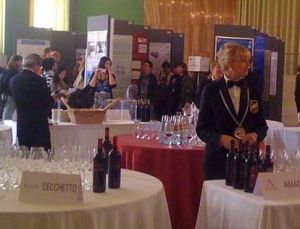
|
On Thursday evening the CIESM Board Members met, amidst paintings by Veronese, Tintoretto, Schiavone and Salviati, in the magnificent Hall of the Biblioteca Nazionale Marciana, built between 1537 and 1553 by Jacopo Sansovino. They elected Croatia, Israel, Tunisia and Turkey to the Advisory Board of the Commission. For the period 2010-2013, these Countries' Representatives will join the four permanent Members (France, Italy, Monaco, Spain). |
|
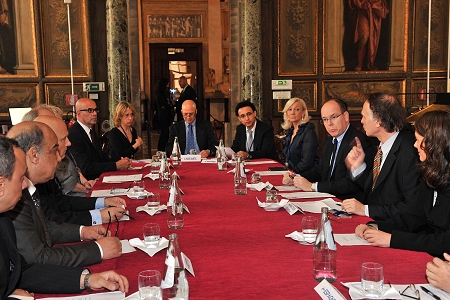 |
|
Board Members did review and validate the result of the elections, by secret ballot, of the Chairs of the six CIESM scientific committees. Were elected: |
|
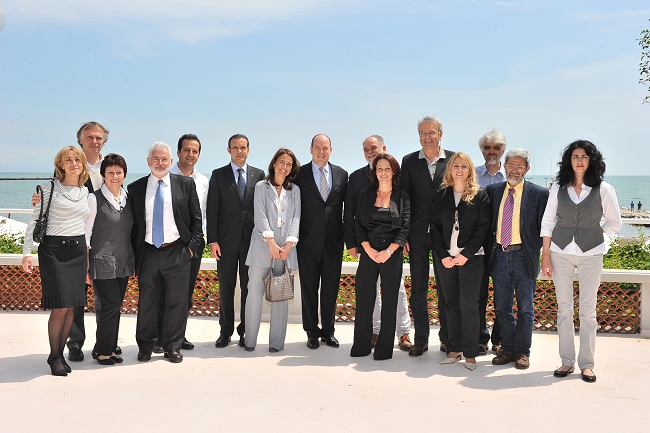
|
|
From left to right: Paula Moschella, Frederic Briand, Monique McLaughlin, Axel Romania, Cemal Turan, Enric Sala, Laura Giuliano, Ferdinando Boero, Michele Barbier, Miroslav Gacic, Annelyse Gastaldi, Gert de Lange, Milton da Costa and Valerie Gollino. |
|

Prince Albert of Monaco and Dr Miroslava Pasaric, winner of the poster prize. |
On Friday, the Best Poster Prize was awarded to Dr Miroslava Pasaric and to her co-authors, from the Geophysical Institute, Croatia, for their communication 'Record-breaking sea levels in the Northern Adriatic on 1st December 2008'. In addition, a special prize of the Jury recognized the quality of the poster presented by Dr Stelios Katsanevakis and Issaris, from the Hellenic Centre for Marine Research, Greece, for their communication ‘Impact of marine litter on sea life: a review’. |

|
|
| The closing of the Congress was marked by a superb reception offered by CIESM at the Teatro delle Tese, within the historical Gaggiandre complex of the Arsenal. This coincided with the opening of Mare Maggio, an annual event celebrating the mariage of the sea and the Venitians. For this occasion, ancient ships were on display for the enjoyement of the hundreds of CIESM scientists still present.
|
|
[Photo credits: Gaetan Luci, Philippe Carlevan, Annelyse Gastaldi] |
|